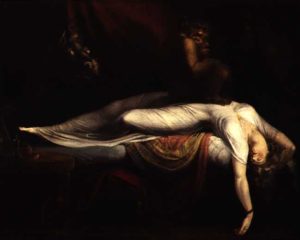In my recent posts, I’ve noted a lack of real physicality in most opera stagings, which — to cite just one problem it causes — can lead to violent moments not looking violent.
Which then makes opera look implausible on stage, unable to do what any action movie, even a bad one, manages with ease.
Which then, I think, undermines any claims we make that opera is great art.
No acting training needed
And in my last post, I said this problem could easily be fixed. Even without opera singers getting much better training as actors than they currently get.
All we’d need, I said, would be a movement coach. And this, I added, wasn’t just a theory. I’d seen it work.
So here’s the story
Early in the 1980s, my Frankenstein opera got a marvelous production, with piano, in a workshop at C.W. Post College on Long Island, not far from New York.
And maybe because this production was done by the theater department, not by an opera department, some theatrical details were handled marvelously. The stage director happened to be an opera guy, but that didn’t change things. He was marvelously theatrical, and maybe had a hand in creating explosive physicality onstage.
Let me quickly give you audio evidence of how well this worked. First, a horrendous offstage scream (1:13). And then a sound that’s midway between a grunt and a convulsive shout, as the Creature brutally stabs someone who’s already dead (0:49), bringing the knife down from high above his head.
About Frankenstein:
I wrote it almost as a 19th century Italian opera (though in English), imagining what Verdi or Bellini might have done, if they’d set Frankenstein to music. (It’s a novel from their era.)
For another sample, here’s a quintet from Act 1 (3:41). (From a New York CIty Opera workshop: Shannah Timms, Marion Capriotti, Paul Mow, Daniel Mobbs, Scott Altman; Brent McMunn, conductor.)
The murder scene
 A truly horrible moment. The Creature murders Victor Frankenstein’s bride, Elizabeth, on her wedding night. To retaliate for Victor Frankenstein’s murder of the bride he was building for the Creature.
A truly horrible moment. The Creature murders Victor Frankenstein’s bride, Elizabeth, on her wedding night. To retaliate for Victor Frankenstein’s murder of the bride he was building for the Creature.
The scene, as envisioned by my marvelous librettist, Thomas M. Disch, has the Creature stabbing Elizabeth repeatedly. Very brutal.
So a movement coach came in, to teach the bass-baritone doing the Creature, Robert Stephens, what a brutal stabbing motion is. And to teach the soprano singing Elizabeth, Carolyn Mallory, how her body would convulse if it were stabbed.
Which made the scene horrendous to watch. Truly frightening.
But that’s how Tom and I wanted it to be.
And there was one last horror
When Elizabeth is dead, the Creature seems to soften. He lays her body out tenderly, on her bridal bed.
And this, everyone would think, would be the end. Except that rage explodes inside the Creature one last time, and he stabs the dead body.
Again the movement coach. He or she taught Robert how to bring his hands above his head to stab with ultimate brutality, straight down. And taught Carolyn how a dead body would twitch if it were stabbed that way.
Horrible, again. But it was meant to be. The scene was very bloody, too. And, I hope, very effective in its music. Very hard to forget, after you’d seen it.
That’s the sonic excerpt I gave you earlier. You’ll hear, fading in, the end of a gentle, Bellini-like orchestral passage, the music of the Creature’s tenderness. And then two clashing chords, when the Creature’s rage returns. As he stabs Elizabeth’s body from above, you’ll hear him half-grunt, half cry out, a ghastly sound suggesting both great emotion and great physical effort.
(From the C.W. Post workshop performance; Robert Stephens; Ralph Zitterbart, piano.)
And then the scream (the sound of which I also gave you earlier)
Victor Frankenstein kills the Creature’s bride offstage, after bringing her to life. He promised — under threats of horrid vengeance — to create her. And then can’t bear what he’s done.
So he kills her. In this production, that was shown in silhouette. So someone played the Creature’s bride, even though she never came on stage.
And she was taught to scream when she was stabbed. To scream horribly. Which again made that moment everything it needed to be. And of course set up the murder scene that followed.
Here’s the scream again. First an offstage chorus, singing in praise of love. Then Victor Frankenstein, vowing to kill the Creature’s bride. Then the chorus again — and the unsettling, beyond horrible scream. (Again from the C.W. Post performance. Allan Glassman; Ralph Zitterbart, piano. And someone uncredited screaming, to whom I’m greatly in debt.)
